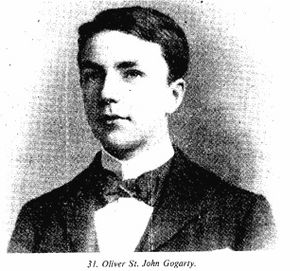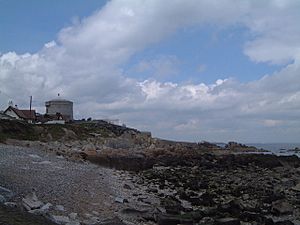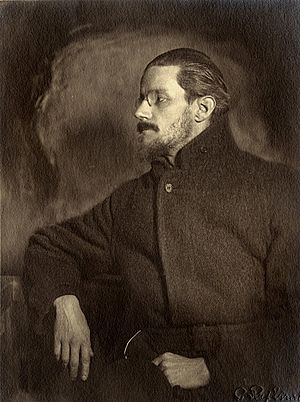Oliver St. John Gogarty facts for kids
Quick facts for kids
Oliver Gogarty
|
|
|---|---|

Oliver Gogarty as painted in 1911 by William Orpen
|
|
| Born | Oliver Joseph St. John Gogarty 17 August 1878 Rutland Square, Dublin, Ireland |
| Died | 22 September 1957 (aged 79) New York City, United States |
| Occupation | Author, poet, memoirist, physician/surgeon, politician, athlete |
| Literary movement | Irish Literary Renaissance |
| Notable works | As I Was Going Down Sackville Street (1937) |
| Spouse | Martha Duane Gogarty |
| Olympic medal record | ||
|---|---|---|
| Art competitions | ||
| Bronze | 1924 Paris | Literature |
Oliver Joseph St. John Gogarty (born August 17, 1878 – died September 22, 1957) was a famous Irish writer and poet. He was also a doctor, an athlete, and a politician. People knew him for his great conversations. He even inspired a character named Buck Mulligan in James Joyce's famous book Ulysses.
Contents
Oliver Gogarty's Life Story
Growing Up in Dublin
Oliver Gogarty was born in Rutland Square, Dublin, Ireland. His father, Henry Gogarty, was a wealthy doctor. His mother was Margaret Gogarty. Oliver was the oldest of four children. His family was different from many Irish Catholic families because they had access to the same social circles as the rich Protestant families.
Oliver first went to O'Connell School in Dublin. He liked it there. But when his father died in 1891, he was sent to a boarding school called Mungret College near Limerick. He didn't like it and later moved to Stonyhurst College in England. He called it "a religious jail."
In 1896, Oliver came back to Ireland. He studied for exams at the Royal University of Ireland. He was a very good athlete. He played soccer for Preston North End FC Reserve in England. In Ireland, he played for the Bohemian FC and also for his college's soccer and cricket teams. He also loved cycling. In 1898, he started studying medicine at Trinity College.
University Days and Friendships
Oliver was a very successful cyclist. He was even banned from races in 1901. Between 1898 and 1901, he saved at least four people from drowning! He became interested in Irish nationalism after meeting Arthur Griffith in 1899. He wrote articles for a newspaper called The United Irishman.
During his time at Trinity College, Oliver also became very interested in poetry and literature. His clever conversations made him popular with his teachers. He won poetry prizes three times. In 1900, he met famous writers like W. B. Yeats and George Moore. He became friends with other young poets, including Seamus O'Sullivan and James Joyce.
In 1904, Gogarty rented the Martello Tower in Sandycove. He wanted to help his friend James Joyce, who needed a place to finish his novel. However, the two friends had a disagreement. Joyce stayed in the tower only for a short time. Later, Gogarty said Joyce left because of some late-night fun with a revolver. Their friendship was never fully the same. Gogarty used the tower as a place to write and have parties until 1925.
In 1905, Gogarty helped start Sinn Féin. This was a peaceful political group that wanted Ireland to govern itself.
Becoming a Doctor and Starting a Family

In August 1906, Oliver Gogarty married Martha Duane. She came from a family that owned land in Connemara. He finished his medical exams in 1907. That same year, his first son, Oliver Duane Odysseus Gogarty (called "Noll"), was born. Oliver then went to Vienna to finish his medical training. He decided to become an otolaryngologist, which is a doctor who specializes in ears, nose, and throat.
When he returned to Dublin in 1908, he started working at Richmond Hospital. He later joined the Meath Hospital, where he worked for the rest of his medical career. He was known for being very dramatic in the operating room. He would tell jokes and even throw removed body parts at the people watching! He also had his own clinic where he treated rich patients and helped poorer ones for free.
Oliver and Martha had two more children: Dermot (born 1908) and Brenda (born 1911). In 1917, Gogarty bought a large country house called Renvyle House in Renvyle, Connemara. He loved driving and bought many cars, including a yellow Rolls-Royce. He also learned to fly planes and helped start the Irish Aero Club.
A Senator for the Free State
During the Irish War of Independence, Gogarty supported the Irish side. He let his home be used as a safe house and drove IRA volunteers in his car. After the war, he supported the new Irish government. His close friend Arthur Griffith was the leader. Gogarty became a Free State Senator. When Griffith died in 1922, Gogarty was very sad. He performed the official autopsy and embalming for both Griffith and Michael Collins, who were also his friends.
In November 1922, an anti-Treaty IRA leader ordered his men to shoot Free State senators. Two months later, Gogarty was kidnapped. He tricked his captors into letting him go outside. He then jumped into the River Liffey and swam to safety. His country house, Renvyle, was also burned down by anti-Treaty forces. After these events, Gogarty moved his family to London for a while. When he returned to Ireland, he famously released two swans into the Liffey to show his thanks for being alive.
Gogarty remained a senator until 1936. He didn't belong to any political party and voted how he wanted. He believed Ireland should stay connected to the British Commonwealth. He supported things like rural electricity, better roads, and school health. He often made jokes and used poetry in his speeches. He was not a fan of the government's efforts to bring back the Irish language. He also often criticized Éamon de Valera, another important politician. De Valera eventually closed the Seanad, ending Gogarty's political career.
Writing Career
Gogarty was good friends with many famous Dublin writers, like W. B. Yeats and George Moore. He kept writing poetry even while being a doctor and politician. He published several poetry books, including Hyperthuleana (1916) and The Ship and Other Poems (1918). He also wrote plays, some of which were performed at the Abbey Theatre.
In the 1920s and 1930s, Gogarty focused more on writing. His poetry book An Offering of Swans won a Gold Medal in 1924. He also won an Olympic bronze medal for his poem Tailteann Ode at the 1924 Paris Olympics. In 1936, W. B. Yeats included seventeen of Gogarty's poems in his Oxford Book of Modern Verse, calling him "one of the great lyric poets of our age."
In 1935, Gogarty published his first prose book, As I Was Going Down Sackville Street. It was a mix of a novel and a memoir about his life in Dublin. He also wrote I Follow St. Patrick (1938), which explored places linked to St. Patrick. His comic novel Tumbling in the Hay (1939) was about medical students in Dublin. In 1938, he had a legal disagreement with a poet named Patrick Kavanagh over something written in Kavanagh's book.
Life in America
When World War II started, Gogarty tried to join the RAF (Royal Air Force) as a doctor, but he was too old. In 1939, he went to the United States for a lecture tour. The war made it hard for him to return home, so he decided to live in America permanently. He lived mostly in New York and also spent time in Vermont and New Jersey.
Gogarty felt he was too old to take the medical exams needed to practice in the U.S. So, he supported himself by writing. He wrote essays, short stories, and several books like Going Native and Mr. Petunia. Many people think his later writings were not as good as his earlier ones.
Oliver Gogarty had heart problems in his last years. He died on September 22, 1957. His body was flown back to Ireland and buried near Renvyle.
How He Appears in Books
Oliver Gogarty was a well-known person in Dublin. He appears in many books written by people who knew him. His most famous appearance is as Buck Mulligan in James Joyce's novel Ulysses. Mulligan often quotes songs and poems that Gogarty actually wrote. One famous one is "The Song of the Cheerful (But Slightly Sarcastic) Jesus". Many details about Buck Mulligan, like being a medical student and saving people from drowning, are based on Oliver Gogarty's real life.
Gogarty's name often comes up in studies about James Joyce. However, some people say that these references are not always correct. They say that people sometimes confuse the real Gogarty with the fictional character Buck Mulligan.
It has also been suggested that the character "Malachi Stilt-Jack" in W. B. Yeats's poem High Talk is meant to be Oliver Gogarty.
Oliver Gogarty's Legacy
There is a pub named after him in the Temple Bar area of Dublin. An annual Oliver St. John Gogarty Literary Festival is held at his family home, which is now the Renvyle House Hotel in Connemara. A surgical ward in the Tallaght University Hospital is also named after him.
William Dawson wrote a poem called The Lay of Oliver Gogarty about his kidnapping and escape.
A documentary film about Gogarty, called Oliver St. John Gogarty: Silence Would Never Do, was made in 1987.
Notable Works
Oliver Gogarty wrote many books and plays. Here are some of his well-known works:
- Hyperthuleana (1916)
- Blight: The Tragedy of Dublin (1917)
- An Offering of Swans (1923)
- Wild Apples (1928)
- As I Was Going Down Sackville Street (1937)
- I Follow St. Patrick (1938)
- Tumbling in the Hay (1939)
- Going Native (1940)
- It Isn't This Time of Year At All!: An Unpremeditated Autobiography (1954)
Images for kids







